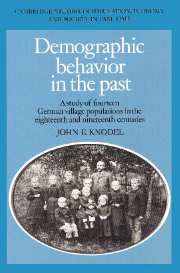 Demographic Behavior in the Past
Demographic Behavior in the Past Book contents
- Frontmatter
- Contents
- List of tables
- List of figures
- Acknowledgements
- PART I INTRODUCTION
- PART II MORTALITY
- PART III FAMILY FORMATION
- PART IV MARITAL REPRODUCTION
- PART V INTERRELATIONSHIPS IN DEMOGRAPHIC BEHAVIOR
- 13 Family size, fertility and nuptiality interrelationships
- 14 Child mortality and reproductive behavior
- PART VI CONCLUSION
- Appendices
- Bibliography
- Index
13 - Family size, fertility and nuptiality interrelationships
Published online by Cambridge University Press: 04 August 2010
- Frontmatter
- Contents
- List of tables
- List of figures
- Acknowledgements
- PART I INTRODUCTION
- PART II MORTALITY
- PART III FAMILY FORMATION
- PART IV MARITAL REPRODUCTION
- PART V INTERRELATIONSHIPS IN DEMOGRAPHIC BEHAVIOR
- 13 Family size, fertility and nuptiality interrelationships
- 14 Child mortality and reproductive behavior
- PART VI CONCLUSION
- Appendices
- Bibliography
- Index
Summary
As indicated in Chapter 6, the feature of demographic behavior that most distinguished western Europe from other traditional societies prior to the secular fertility decline was a flexible nuptiality pattern characterized by relatively late ages of marriage for both men and women and substantial proportions who remained single throughout their adult years. Ever since Malthus called attention to the ‘preventive check,’ most analysts have recognized the central position of nuptiality in the European preindustrial demographic system. Delayed or foregone marriage generally meant delayed or foregone reproduction, which was compensated for only in small part by non-marital reproductive activity. Social controls on entry into marriage, and hence the formation of socially sanctioned reproductive unions, were a crucial force in moderating population growth and provided the major adjustive mechanism through which a community's population and resources were kept in some sort of rough balance. Interrelationships between nuptiality and fertility and their consequences for family size, as they existed within the sample village populations, thus deserve close examination.
Trends and variation in family size
In studies based on family reconstitution data, family size is typically defined as the number of children born to couples whose marriage remained intact throughout the wife's reproductive span. Such marital unions are conventionally referred to as completed families in historical demography. In contrast, unions that are prematurely dissolved by death (or occasionally divorce) before the end of the childbearing years are referred to as incomplete.
- Type
- Chapter
- Information
- Demographic Behavior in the PastA Study of Fourteen German Village Populations in the Eighteenth and Nineteenth Centuries, pp. 353 - 392Publisher: Cambridge University PressPrint publication year: 1988


